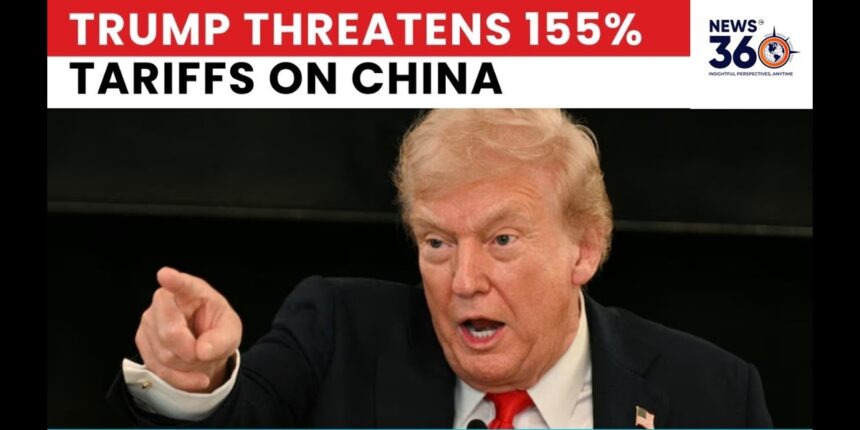Trump’s 155% Tariff Threat: Analyzing the Imminent Trade War Deadline with China
President Trump just dropped a bombshell. He warned of slapping 155% tariffs on Chinese goods if no trade deal happens by November 1. This comes right before his big meeting with Xi Jinping. Global markets shook at the news. Stocks dipped fast. Everyone wonders what this means for prices at the store and jobs here at home.
Think about it. We’ve seen trade fights before. But this feels like the breaking point. U.S. firms rely on cheap parts from China. Consumers grab gadgets and clothes from there too. A hike like 155% could flip everything upside down. The stakes couldn’t be higher as Trump pushes for a win in talks.
Read More : https://news360live.in/trump-imposes-100-tariff-on-china-amid-rare-earth-restrictions/
The Anatomy of the 155% Tariff Escalation
Defining the Proposed Steep Tariffs
The 155% tariff threat targets key Chinese imports. It hits consumer electronics like phones and laptops. Auto parts and machinery fall under it too. Right now, Section 301 tariffs sit at 25%. Jumping to 155% would triple that pain. Importers face a wall of costs overnight.
This isn’t just talk. Trump aims to force changes in how China does business. Goods worth billions could see prices soar. Small tweaks in the plan might spare some items. But the core idea stays firm: pay up or face the hit.
Experts call this a shock tactic. It puts pressure on Beijing fast. U.S. buyers scramble to adjust. The 155% figure grabs headlines for a reason.
Historical Context: Previous Tariff Rounds and Impact
Back in 2018, Trump started with 25% tariffs on steel and aluminum. China fired back with duties on U.S. soybeans. Trade volumes dropped by 15% in the first year, per U.S. Census data. Importers passed costs to buyers. That raised prices on washing machines by 12%.
Later rounds added tariffs on $300 billion in goods. U.S. manufacturers lost edges in supply chains. Some shifted to Taiwan or Mexico. But many stuck with China due to low costs. Jobs in farming took a hit from lost exports.
These steps set the stage. They showed tariffs bite both sides. Now, with 155% in play, the game ramps up. Past pain warns of bigger trouble ahead.
The November 1st Deadline and Strategic Timing
Trump picked November 1 for a reason. It builds buzz before the Trump-Xi meeting in early November. The date gives negotiators just weeks to hash out a deal. It’s like a countdown clock in a thriller movie.
This timing boosts U.S. leverage. China wants to avoid a holiday shopping mess. U.S. consumers buy big in fall. Tariffs right then would sting extra hard. Trump bets on that fear to get concessions.
Leaders on both sides know the risks. A missed deadline means chaos. The summit could save the day or spark a full trade war.
Economic Ramifications for US Industries and Consumers
Impact Analysis on Major Importing Sectors
Retail stores depend on China for 40% of apparel. A 155% tariff would jack up clothing prices by 50% or more. Tech firms like Apple source hardware there too. Delays in parts could halt production lines.
Farmers worry about backlash. China might slap tariffs on U.S. corn and pork again. Last time, exports fell 20%. Supply chains need quick fixes. Firms eye Vietnam for sewing or India for chips.
Costs add up fast. Businesses face higher bills for shipping and storage. Jobs in logistics might grow, but others vanish. The shift hurts short-term.
- Retail: Expect empty shelves if orders slow.
- Tech: Gadget prices climb, sales dip.
- Auto: Car costs rise, buyers wait.
Inflationary Pressure and Consumer Price Index (CPI) Forecasts
Tariffs like 155% feed straight into inflation. Economists at the Peterson Institute say CPI could jump 2-3 points. Everyday items get pricier first. A TV that costs $300 now might hit $450.
Think tanks like Brookings warn of a pass-through effect. Importers eat some costs, but most go to you. Families feel it in grocery bills too, if food chains break. Last trade spat added 0.4% to CPI.
One expert notes, “Tariffs act like a tax on shoppers.” We see it in higher tags at Walmart. Forecasts show pain lasting into 2020. Your wallet takes the brunt.
Stock Market Volatility and Investor Sentiment
Markets hate surprises. After Trump’s announcement, the Dow dropped 400 points in a day. Tech stocks like Qualcomm tumbled 5%. Investors flee uncertainty.
Big firms give cautious outlooks. Nike warns of margin squeezes from tariffs. Wall Street watches every tweet from Trump. Bond yields dip as safe bets rise.
Sentiment turns sour. Funds pull from China-linked plays. But some see buys in U.S. makers. Volatility keeps traders on edge. The Trump-Xi meeting looms large.
China’s Potential Response Scenarios
Diplomatic Stance Ahead of the Summit
Beijing calls the 155% threat “unfair pressure.” Trade reps say China stands ready to talk. But they won’t bow to bullying. Xi’s team signals calm talks at the summit.
Past statements show firmness. China draws lines on core issues like tech rules. Officials hint at progress on purchases. Yet, they stress mutual respect.
The stance buys time. It keeps doors open without quick gives. Watch for subtle shifts before November 1.
Countermeasures Beyond Tariffs
China has tricks up its sleeve. They could slow approvals for U.S. firms in their market. Think Boeing planes or Starbucks stores facing red tape.
Rare earth exports matter too. China controls 80% of them for batteries and chips. A cut-off would hurt U.S. defense and EVs. In 2019, they eased rules on some U.S. drugs as a nod.
Other moves include currency tweaks. The yuan might weaken to offset tariffs. These steps hit without full war. Businesses brace for the squeeze.
- Regulatory delays: U.S. banks wait longer for licenses.
- Export curbs: Key minerals get scarce.
- Boycotts: Subtle pushes against American brands.
Negotiating Leverage: What China Needs to Concede
Trump wants real changes. Top demand: better IP protection for U.S. firms. China must stop forced tech transfers too.
Market access tops the list. Open doors to financial services and agriculture. Beijing agreed to buy more U.S. energy last round. Now, they need to deliver.
Concessions mean reform. China eyes state firms’ role in trade. A deal averts 155% pain. But red lines like sovereignty stay firm.
Navigating the Uncertainty: Actionable Strategies for Businesses
Supply Chain Diversification: Moving Beyond “China Plus One”
Don’t wait for the hammer to fall. Start scouting Vietnam for assembly lines. Mexico offers quick shifts for auto parts. India grows fast in textiles.
Assess risks now. Map your suppliers. Test new vendors with small orders. Costs rise at first, but long-term savings beat tariffs.
Here’s a quick checklist:
- List all China-dependent products.
- Rank them by tariff exposure.
- Contact three alternate countries.
- Run a trial shipment.
Nearshoring cuts delays. It builds resilience. Act before November 1 hits.
Hedging Currency Risk in Uncertain Trade Environments
Trade fights swing the yuan against the dollar. Lock in rates with forward contracts. Banks offer tools to fix costs for six months.
Futures markets help too. Buy options if you export to China. This shields against drops. Small firms use apps from firms like CME Group.
Keep cash in stable spots. Diversify holdings to ease swings. It’s basic insurance for your bottom line.
Lobbying Efforts and Policy Advocacy
Join forces with trade groups. The U.S. Chamber pushes back on high tariffs. They meet lawmakers weekly.
Write letters to your reps. Share how 155% hurts your shop or factory. Coalitions amplify voices. Before November 1, flood D.C. with facts.
Success stories exist. In 2019, soy farmers won exemptions. Your input sways votes. Speak up now.
Conclusion: Awaiting the Trump-Xi Showdown
The 155% tariff warning sets a tense stage. November 1 marks a fork in the road for U.S.-China trade. The Trump-Xi meeting could seal a deal or ignite more fights. Industries brace, consumers watch prices, and markets jitter.
No matter the outcome, prep matters. Diversify chains, hedge risks, and advocate hard. This clash shapes global flows for years. Stay ahead—your business depends on it. What steps will you take today?

